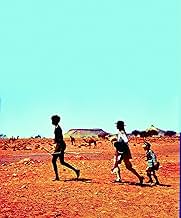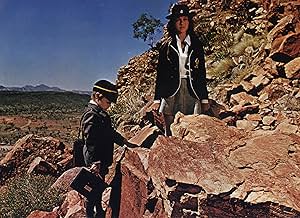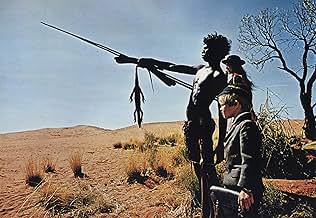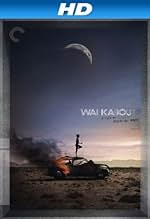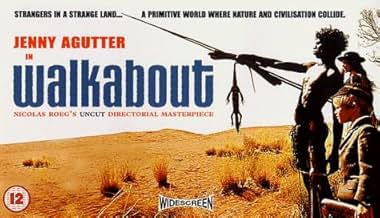Dois irmãos criados na cidade estão confinados na Austrália, onde aprendem a sobreviver com a ajuda de um menino indígena.Dois irmãos criados na cidade estão confinados na Austrália, onde aprendem a sobreviver com a ajuda de um menino indígena.Dois irmãos criados na cidade estão confinados na Austrália, onde aprendem a sobreviver com a ajuda de um menino indígena.
- Direção
- Roteiristas
- Artistas
- Prêmios
- 1 vitória e 1 indicação no total
David Gulpilil
- Black Boy
- (as David Gumpilil)
Robert McDarra
- Man
- (as Robert McDara)
Peter Carver
- No Hoper
- (as Pete Carver)
Noeline Brown
- German Scientist
- (as Noelene Brown)
George Roubicek
- Radio Announcer
- (narração)
- (não creditado)
- Direção
- Roteiristas
- Elenco e equipe completos
- Produção, bilheteria e muito mais no IMDbPro
Avaliações em destaque
"In Australia, when an Aborigine man-child reaches sixteen, he is sent out into the land. For months he must live from it. Sleep on it. Eat of its fruit and flesh. Stay alive. Even if it means killing his fellow creatures. The Aborigines call it the WALKABOUT. This is the story of a 'WALKABOUT'." Thus begins Nicolas Roeg's 1971 debut feature, "Walkabout", one of the most beautiful, mystical, and magical film I've had the privilege of seeing as a filmgoer. Seeing it again recently on the beautiful Criterion edition DVD, I was once more captivated by this film as it slowly worked its magic on me. The "plot" of "Walkabout" is simplicity itself: a teenage girl (Jenny Agutter) and her little brother (the director's son in real life, Lucien John Roeg--billed "Lucien John" on the credits) are stranded on an Australian outback as their father, who took them out for a picnic, suddenly and inexplicably commits suicide. The two of them are thus left wandering by themselves and it looks as if they will die in the vast wilderness--until they encounter an Aborigine boy who is on his "walkabout," an Aborigine rite of passage into manhood. For a time these kids travel together as a trio and the Aborigine's skills in hunting and finding water allow them to survive. And although the girl and her brother will eventually find their way back to civilization, for a brief unspecified length of time the exotic Australian outback becomes a wondrous and mystical place where their story of survival unfolds. If you've seen this film, you know that the brief synopsis above doesn't really touch what is so special about "Walkabout." And that is because "Walkabout" isn't really about plot, like more conventional films. It is one of those rare films like Peter Weir's "Picnic at Hanging Rock," Terrence Malick's "Days of Heaven," and Wim Wender's "Wings of Desire" which are all about evoking a kind of sad and bittersweet emotional response from us. I think that is what "Walkabout" is mostly about. The overall impact of this film "hits you in the heart" and very impressionable viewers might be stirred in their emotions to the point of swooning in the scene at the end where the girl, now a married woman, remembers her idyllic days happily swimming in one of the outback's water holes Nicolas Roeg was not only the director of "Walkabout" but also its cinematographer. And his photography in this film is unbearably beautiful and sumptuous. "Walkabout" is without a doubt one of the most gorgeous color films ever made. Shot on location in the Australian outback--perhaps one of the most exotic places on earth--"Walkabout" has a visual grandeur that is reminiscent of passages from David Lean's "Lawrence of Arabia" and John Ford's "The Searchers." Never has the "voodoo of location shooting" (as Werner Herzog likes to call it) been more manifest than in this film. In fact, the exotic and unique location in which it was shot, coupled with Roeg's masterful cinematography, feels like one of the main characters in "Walkabout." The film's location adds a mystical (almost spiritual) and meditative dimension to it which lingers in the viewer's mind--haunting it long after the film is over. If Roeg's photography is one of the film's main characters, so is John Barry's legendary and justly famous score. Maybe it's the harp used in the score, or the subtle billowing quality of its composition (i.e. the way its beautiful melody gently builds and builds), but the music in this film simply soars. It moves me like no other score I've ever heard. It feels completely transcendent, as if it exists outside time and space altogether--but gently swooping down from time to time, "kissing" this film's images with aching sweetness. All of the above elements work together to form a film-viewing experience that inspires both beauty and awe in us. The film's message is not necessarily that life in the outback is better than life in a modern civilization, but that no matter where you happen to find yourself (even if that happens to be a wilderness like the Australian outback), if you have resources that meet your basic needs, it can become your "home" for a time. And that afterwards there is bitter-sweetness in reminiscing about those "good times" you were fortunate enough to have--to which you can never return again.
A teenaged girl (ever-lovely Jenny Agutter) and her young brother (Lucien John, a.k.a. Luc Roeg, the directors' son) are stranded in the desolate Australian outback. They really have no clear idea of where to go or what to do, but they meet a stranger who saves their lives. He is an aborigine (Aussie icon David Gulpilil) who is partaking in the ritual known as "Walkabout", wherein he temporarily leaves his tribe to go off on his own and live off the land.
The experiences between these three young people form the balance of this excellent film. The culture clash is immediate, as the two urbanized white kids struggle to make themselves understood by the aborigine. But they ultimately become rather inseparable.
Along the way, they encounter all sorts of flora and fauna. "Walkabout" is highly noteworthy for its respect for Nature, and is filled with many visual wonders. Given that director Nicolas Roeg had been a camera operator and cinematographer, it's no surprise that the film *looks* beautiful, and it's set to a haunting and lovely John Barry score.
Three highly engaging performances anchor the film. Agutter has a naturally sexy presence, and Roeg doesn't miss opportunities to let the camera take in every aspect of her body. His son does a nice job as the brother, avoiding being overly cutesy and always relaxed on screen. Gulpilil proved to be a real find in his film debut. Another Aussie favourite, John Meillon, appears briefly as the white kids' father.
"Walkabout" was largely improvised. The Edward Bond script, based on a novel by Donald G. Payne, was actually only 14 pages or so. Knowing this, it makes the acting that much more impressive, as the cast react instinctively to the scenes & settings.
Overall, this is one of *the* iconic Australian films, and is a must-see for movie lovers interested in cinema from this part of the world.
Eight out of 10.
The experiences between these three young people form the balance of this excellent film. The culture clash is immediate, as the two urbanized white kids struggle to make themselves understood by the aborigine. But they ultimately become rather inseparable.
Along the way, they encounter all sorts of flora and fauna. "Walkabout" is highly noteworthy for its respect for Nature, and is filled with many visual wonders. Given that director Nicolas Roeg had been a camera operator and cinematographer, it's no surprise that the film *looks* beautiful, and it's set to a haunting and lovely John Barry score.
Three highly engaging performances anchor the film. Agutter has a naturally sexy presence, and Roeg doesn't miss opportunities to let the camera take in every aspect of her body. His son does a nice job as the brother, avoiding being overly cutesy and always relaxed on screen. Gulpilil proved to be a real find in his film debut. Another Aussie favourite, John Meillon, appears briefly as the white kids' father.
"Walkabout" was largely improvised. The Edward Bond script, based on a novel by Donald G. Payne, was actually only 14 pages or so. Knowing this, it makes the acting that much more impressive, as the cast react instinctively to the scenes & settings.
Overall, this is one of *the* iconic Australian films, and is a must-see for movie lovers interested in cinema from this part of the world.
Eight out of 10.
A remarkably potent little film about a couple of very proper English kids who get lost in the Australian outback and hitch up with an aborigine boy on his initiation quest (or "walkabout"). My mom took me to see it when I was ten, and I've been haunted by it ever since. With some understated yet disturbing themes of alienation and violence, as well as the first scenes of full nudity I had ever witnessed on screen, I've sometimes wondered whether mom knew what she was getting into when she took me along. According to the trailer in the letterbox edition, Parents' Magazine recommended the film "without reservation" for young and old alike, because it depicts "facts of life." While that may be true, times have changed, and I can't imagine anyone today describing this subtle and unsettling story as "family fare." Incredibly tame, on its face, by today's standards of sensory overload, its essential world-weariness and maturity is no longer a didactic priority in our age of overconfidence. Watching it recently, I was on guard for signs of the myth of the "noble savage"--the hackneyed, simplistic, and generally hypocritical pretension that pre-industrial and non-Western peoples are morally superior to decadent moderns, which is demeaning to both modern and "savage" alike. There are instances of it here--most notably when a couple of rifle-toting, four-wheeling hunters decimate the landscape--but the overall emphasis is on the parallels between aborigine and Western life. Even scenes of the transience and decay of modern civilization are mirrored by the life-and-death cycles of the wilderness. With so many underlying similarities, the real question is why the teenaged English girl cannot embrace, figuratively and literally, the young black man who has saved her life and provided so selflessly for her, even while her younger brother, in all his innocence, has never doubted that they are a family. Is it race? Culture? Or does it reach to more fundamental questions of boy and girl, man and woman, human and human? This film has held up remarkably well over the past 30 years, and is well worth a look.
I first remember seeing this film as a late teenager in about 1979. Therefore what most vividly stuck in my mind was the lead character played by a beautiful blonde English girl, Jenny Agutter, Specifically the nude scenes of her swimming and washing.
On a less superficial level it is a film with a point-something along the lines of the graciousness of Aborigines and their ability to live in harsh surrounds, and the destructive nature of suburban life in a flat in a major city.
I think it would be a film, like Jedda, that will always be on reference for the Australian Outback, Aboriginals and the modern society which brought a European civilisation to their land.
On a less superficial level it is a film with a point-something along the lines of the graciousness of Aborigines and their ability to live in harsh surrounds, and the destructive nature of suburban life in a flat in a major city.
I think it would be a film, like Jedda, that will always be on reference for the Australian Outback, Aboriginals and the modern society which brought a European civilisation to their land.
10Tophee
Superb cinematography, the Australian outback comes alive in this film of self discovery and regret. Agutter plays the English girl brilliantly, incapable of comprehending anybody or anything that doesn't conform to her middle-class values and upbringing. Roeg is also excellent as her brother, adapting to each and every change in circumstance as only children can. I have watched this movie many times, and always get something new from it. Highly recommended to anyone, although parents might want to watch it before letting their kids see it.
Você sabia?
- CuriosidadesLuc Roeg was actually sun-burnt in the scene where the aboriginal boy treats his back by rubbing him with fat from a wild boar. Director Nicolas Roeg thought it would make a good scene for the film so he picked up the camera and shot it.
- Erros de gravaçãoThe credits name the actor playing "Black Boy" as David Gumpilil. It should be David Gulpilil.
- Citações
Narrator: [last lines - from "Poem XL" by A.E. Housman's "A Shropshire Lad"] Into my heart an air that kills, From yon far country blows: What are those blue remembered hills, What spires, what farms are those? That is the land of lost content, I see it shining plain, The happy highways where I went, And cannot come again.
- Cenas durante ou pós-créditosAfter the credits, there is a flash of white light on the screen and as it becomes a black screen, radio tuning is heard while the words "rien ne va plus" are shown.
- Versões alternativasA director's cut of this movie was released in 1997 with 5 additional minutes. This cut is identical to the original British release version (100 minutes): the film was shortened by five minutes for its original American release.
- ConexõesEdited into Terror Nullius (2018)
Principais escolhas
Faça login para avaliar e ver a lista de recomendações personalizadas
- How long is Walkabout?Fornecido pela Alexa
Detalhes
- Data de lançamento
- Países de origem
- Idiomas
- Também conhecido como
- Encuentro de dos mundos
- Locações de filme
- Empresas de produção
- Consulte mais créditos da empresa na IMDbPro
Bilheteria
- Orçamento
- AU$ 1.000.000 (estimativa)
- Faturamento bruto mundial
- US$ 1.888
Contribua para esta página
Sugerir uma alteração ou adicionar conteúdo ausente



